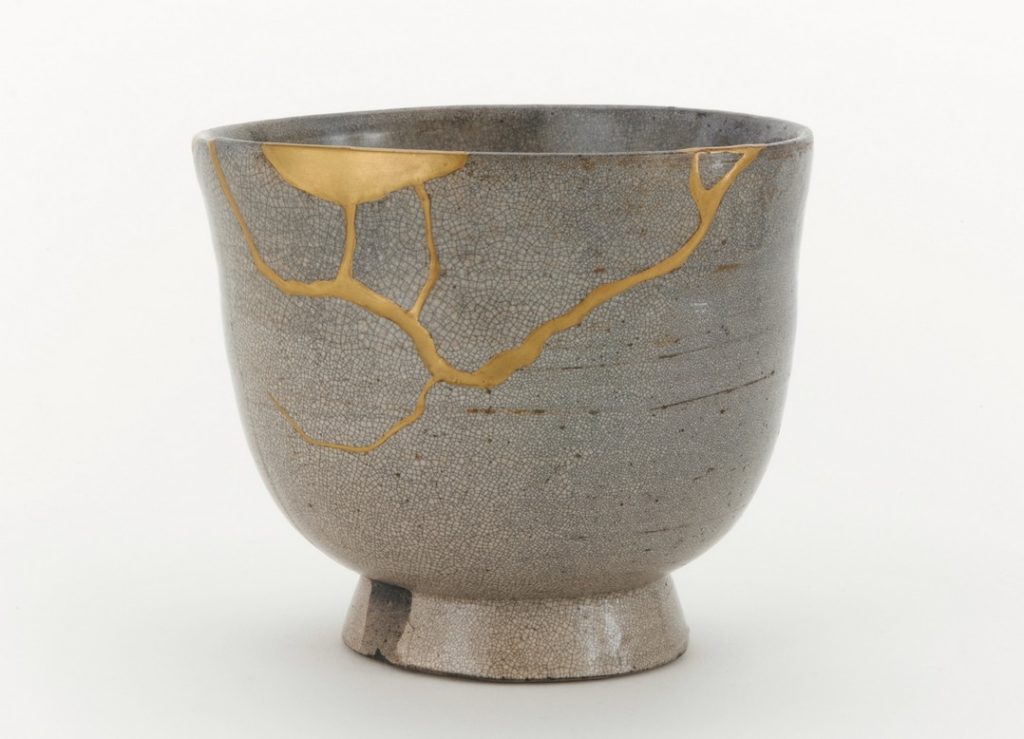Source: OINOS Educational Consulting
By Frank Marangos, D.Min., Ed.D., F.C.E.P.

Tea bowl, Satsuma ware, White Satsuma type, Kagoshima prefecture, Japan, 17th century, Edo period, Stoneware with clear, crackled glaze, stained by ink; gold lacquer repairs, F1904.323.
Ernest Hemingway
What does the memory of the horrific killing of nearly 3,000 people have to say to the psyche of the American nation? And, in particular, what message does the tragic memorial of brokenness offer the country’s nonprofit and faith-based organizations? What is it that we should “never forget?” The ancient Japanese art of Kintsugi may provide one of several potent emblematic responses to the aforementioned questions.
Kintsugi, literally translated as “golden joinery,” is the ancient art of repairing broken pottery by filling its irregular seams with a lacquer bonding agent comprised of tree sap and gold. Dating back to the 15th Century, Kintsugi is commonly identified with the Japanese Shōgun, Ashikaga Yoshimasa (1449 – 1473 CE), who challenged his craftsmen with developing a more aesthetical method of repairing broken “chawans” (tea bowls).
Using precious metals, gold, and tree sap, Japanese artisans decided to refurbish pieces of broken pottery by drawing attention to, rather than away from, its flaws. The new approach had the effect of making the breaks the most important features of the earthenware. Remarkably, while the original ceramic was made useful again, the inventive procedure, artistically accentuated its broken history. In the end, the pottery’s flaws were actually used to magnify its aesthetic value.
CLICK to view Kintsugi Tea Bowl at Smithsonian’s Freer Gallery of Art.
There are three predominant styles of Kintsugi: (1) crack, (2) piece method, and (3) joint-call.
- Crack – Objects mended in this fashion are touched up with minimal lacquer. This is the most common Kintsugi technique, and it culminates in the shimmering veins that have come to define the art form.
- Piece Method – Works restored with the piece method feature replacing breaks and filling holes with fragments made entirely of epoxy.
- Joint-Call – Pottery repaired using the joint-call technique employs similarly-shaped pieces from other broken wares, combining two aesthetically different works into one uniquely unified product.
As a philosophy, Kintsugi can help us treat societal flaws and breaks as part of our history rather than shameful features to disguise. It can help us learn that in the scars and fault lines of our personal and interpersonal stories, lay veins of hidden gold, that, when discovered amidst the rubble of life, can once again make us whole, and perhaps, even stronger and more beautiful than we once were.
In her book, Kintsugi Wellness: The Japanese Art of Nourishing Mind, Body and Spirit (2018) bestselling author, chef and health journalist, Candice Kumai, uses the concept of Kintsugi to provide a road map for a “life lived better.” Returning to her Japanese heritage, Kumai’s book features practical suggestions for helping “individuals find themselves when they are lost, broken and unable to get back to their roots.” “It’s beautiful to think of this practice as a metaphor for your life,” suggests Kumai, “to see the broken, difficult or painful parts of you as radiating light, gold and beauty.”
Like Kumai, psychologist Tomás Navarro considers Kintsugi as “a way through which people can repair and embrace rather than conceal troubles and emotional wounds.” In his book, Kintsugi: The Japanese Art of Embracing the Imperfect and Loving Your Flaws (2018), Navarro describes the brokenness of losing a job, health, or a loved one, to a precious vase falling to the ground and shattering. “Everyone faces suffering,” he insists, “but how we engage and heal our wounds can make all the difference.” Navarro recommends that art be used as a tool for healing. As examples, he recommends writing, building a sandcastle, learning to crochet, doing a collage; anything that occupies the mind.
“Just as a ceramic is fragile, beautiful and strong, so are we,” insists Navarro. “And just as ceramics can break, so too can they be repaired. Ceramics and life can break into a thousand pieces, but that should be no reason to stop living life intensely, working intensely and keeping alive all our hopes and dreams. Adversity,” writes Navarro, “is nothing more than a challenge.”
Celine Santini, author of Kintsugi: Finding Strength in Imperfection (2019), is yet another contemporary proponent of the Kintsugi artform. She argues that its methodology “is an incredible metaphor for healing and recovery from adversity. The philosophy behind it,” explains the winner of the 2019 Golden Nautilus Book Award, “goes much deeper than a simple artistic practice. Nowadays it has also become a well-known therapy metaphor to resilience.” Consequently, like Kumai and Navarro, Santini suggests that the methodology of Kintsugi can be employed “to help the broken overcome rough times, heal deep wounds, and become whole again through its numerous stages.”
According to Santini, the process of Kintsugi is compatible with a six-step method of resilience and emotional repair: (1) Break, (2) Assemble, (3) Wait, (4) Repair, (5) Reveal, and finally, (6) Sublimize.
Step 1 – Break: Like a piece of pottery that has been broken into a thousand pieces a fragmented individual may also be restored into someone more beautiful and precious than before. According to Santini, in order to do so, one must first accept and gather the “splinters” that resulted from an initial break. Instead of discarding a person like a damaged object, a decision must then be made to seek a “second chance” to rebuild a “second life.” During this initial step, one must “imagine, be creative, dare to think differently, and focus on the repair that will provide “splendor.”
Step 2 – Assemble: Step two entails gathering the broken fragments of one’s life and re-assembling them like the pieces of a hastily unfurled puzzle. During this step, however, Santini suggests that one must first clean the pieces and assemble the proper tools. For example, the binding agent used in Kintsugi to cement broken ceramic pieces together is a resin lacquer. Related to poison ivy, the sap-like resin is toxic when in liquid form, but once cured is harmless. Often referred to as a natural plastic, the lacquer creates a relatively water-resistant and durable repair, but requires a time-consuming, multi-step process. While at first irritating, when dry, it hardens and loses its toxicity. Santini suggests that a similar process must be undertaken by an individual in need of assemblage. Restoration must, therefore, include replacing, what she calls, “the poisons” of one’s past, with the appropriate “antidotes.”
Step 3 – Wait: During the third step of a Kintsugi-like method of emotional repair, one must have patience. After the superfluous is carefully scraped and removed, Santini recommends that “the soul must be allowed to breathe.” Like the lacquer that must paradoxically be allowed to breathe, dry, and harden, broken individuals must also wait patiently for emotional flaws “to dry and find a breath of new life.”
Step 4 – Repair: When a ceramic that is being repaired is perfectly dry, its binding traces must be cleaned and polished. Its surfaces must, subsequently, be sanded perfectly smooth. As some irregularities are difficult to discern with the naked eye, Kintsugi artisans pass their fingers over a pottery’s fault lines. If needed, a second very fine coat of lacquer is reapplied. The same method is required, Santini advises, when “repairing” the fault lines of a broken life.
Step 5 – Reveal: According to Santini, the “reveal” is the pan-ultimate step of Kintsugi art, during which an individual like an object “is sublimated with gold powder and finally reborn.” Here, the precious nature of the gold, used to fuse pottery pieces, must be understood as a metaphor that signifies the strength, confidence, and value that might, likewise, be used to repair personal as well as interpersonal cracks and breaks.
Step 6 – Sublimize: An individual, like a piece of broken pottery, is “sublimized” (elevated; exalted) by the art of Kintsugi. It is ready to shine. During this sixth and final stage, Santini recommends “taking a step back and contemplating the repaired and sublimized object in all its unity, wearing with nobility its gold scars.” One should “admire the broken object (individual) that has been transfigured into a precious work of art. It is now unique and priceless,” she suggests. Finally, and perhaps most importantly, we should “contemplate and remember the story that this object carries in its scars. Accept with pride its imperfection . . . as it is more beautiful and more precious once broken and repaired.” As Santini recommends, we are now ready “to present and tell our story to inspire others that it is possible to repair.”
For Kintsugi master artisans, a reconstructed “chawan” is celebrated as a symbol of renewal, strength, and beauty. As people, the obstacles of life that appear to overwhelm can similarly be distinguished as encounters that actually authenticate our true nature by creating golden threads of experience that run like fault lines across our souls, pushing us to emerge bolder, wiser, and more noble.
From a cursory examination of the Kintsugi artform, it is apparent that its methodology provides a wonderful metaphor for our nation’s 20-year memorial of 9-11. What is true of pottery, is true of a nation and its people. Like the golden fault lines running through a Kintsugi vase, the broken of heart, mind, and spirit can also be restored. The manner of such repair, however, requires the gold bonding lacquer of humility, repentance, patience, new learning, and commitment. In an age overly focused on perfection and strength, Kintsugi teaches us that imperfection, fragility, and brokenness should not be disguised or minimized. On the contrary, scars and fissures are valuable, for they provide opportunities for greater self-awareness, honesty, and growth.
According to Amos, the Old Testament “Prophet of Doom,” God is The Master Kintsugi Artist. Although he foretold the destruction of the Temple of Jerusalem, Amos also prophesized that God would one day “restore David’s fallen shelter . . . repair its broken walls, restore its ruins, and rebuild it” (Amos 9:11). While, at the time, the Nation of Israel interpreted the prophet’s message as referring to their nation’s most important religious edifice, later generations would come to understand his prophecy as pertaining to an individual’s body, which, according to Saint Paul, is “the Temple of the Holy Spirit” (I Cor. 3:16).
Consequently, when wedded to Holy Scripture, Kintsugi provides a valuable message for our nation’s 20th memorial of brokenness. Apart from the restoration of what once were two physical national structures, we might find solace in knowing that God is also able to mend personal and societal “brokenness.” According to the prophet Isaiah, we are the “clay” and God is the “Potter” (Isaiah 64:8). Saint Paul echoed a similar message when he wrote that we are all “God’s handiwork” (Ephesians 2:10). As the Master Kintsugi Artisan, the Creator knows our potential, and can in fact heal and repair the cracks and scars of our lives. It is here significant to note that when Jesus rose from the dead, his scars remained. Apart from being a reminder of pain and suffering, His wounds were also a testimony to the restorative power of the Resurrection. St Thomas Aquinas is correct, “He (Christ) kept His scars not from inability to heal them, but to wear them as an everlasting trophy of His victory.”
Brokenness, disorientation, confusion, despondency, dejectedness, and hopelessness are experienced every day by millions of people. They need someone who can cry with them, who can “feel their pain.” As either a phycological or faith-based metaphor, Kintsugi takes on a different meaning for each survivor who is willing to humbly place the broken pieces of their lives into its recasting process. In some cases, the break may have occurred during childhood. For others, their crack may be a result of misplaced trust, infidelity, or personal failure. In all instances, the ways of Kintsugi can apply to a valuable healing “joinery” for each survivor.
In the 3rd-century, a skeptic named Celsus ridiculed a Christian teacher of the day called Origen. “When most teachers go forth to teach, they cry, ‘Come to me, you who are clean and worthy.’ In so doing, these teachers are followed by the highest caliber of people available. But you, O silly master Origin cry, ‘Come to me, you who are down and beaten by life,’ and so you accumulate the rag, tag and bobtail of humanity around you.”
“Yes,” replied Origin, “You are right. They are the rag, tag and bobtail of humanity. But Jesus does not leave them that way. Out of material you would have thrown away as useless, He re-fashions humanity, giving back to them their self-respect, enabling them to stand on their feet and look God in the eyes. They were cowed, cringing, broken things. But the Son has set them free.”
Kintsugi has much to teach the nation’s nonprofit and faith-based organizations as they strive to minister to the fragmentation that currently characterizes our country’s cultural, political, and spiritual psyche. Apart from its ophthalmic value, the logic of the 15th Century artistic technique is capable of inspiring our nation not to censor or conceal the effects of its brokenness – especially as it memorializes the terrorist attack of 9-11.
No nation, ethnic group, family, or individual is perfect, flawless, or without bruises. However, by honestly reviewing their respective faults, flaws, and sorrows, each segment of society may engage a restorative “joinery” that has the power to actually discover gold in brokenness.



